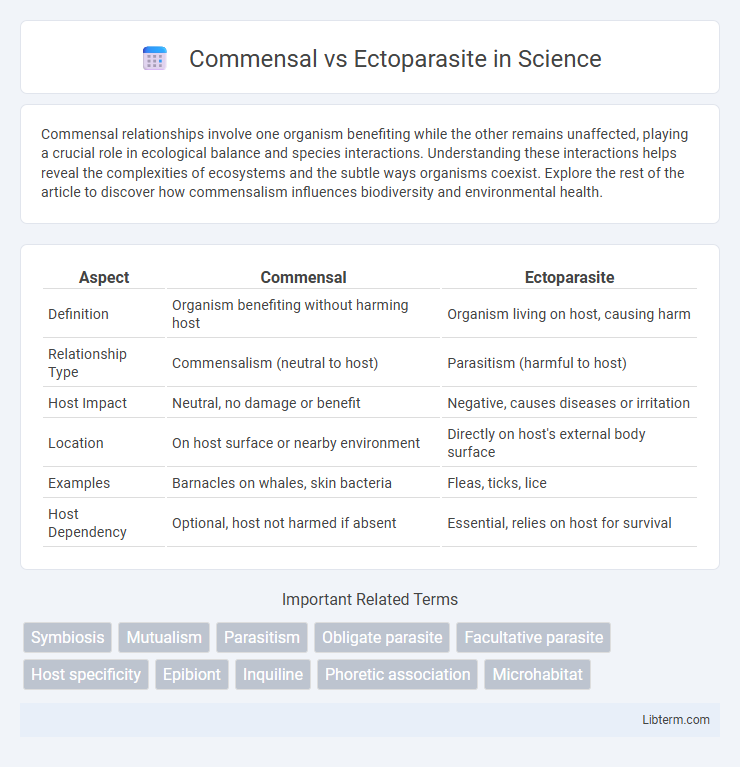Commensal relationships involve one organism benefiting while the other remains unaffected, playing a crucial role in ecological balance and species interactions. Understanding these interactions helps reveal the complexities of ecosystems and the subtle ways organisms coexist. Explore the rest of the article to discover how commensalism influences biodiversity and environmental health.
Table of Comparison
| Aspect | Commensal | Ectoparasite |
|---|---|---|
| Definition | Organism benefiting without harming host | Organism living on host, causing harm |
| Relationship Type | Commensalism (neutral to host) | Parasitism (harmful to host) |
| Host Impact | Neutral, no damage or benefit | Negative, causes diseases or irritation |
| Location | On host surface or nearby environment | Directly on host's external body surface |
| Examples | Barnacles on whales, skin bacteria | Fleas, ticks, lice |
| Host Dependency | Optional, host not harmed if absent | Essential, relies on host for survival |
Introduction to Commensalism and Ectoparasitism
Commensalism is a biological relationship where one organism benefits while the other is neither harmed nor helped, often seen in species sharing habitats like barnacles on whales. Ectoparasitism involves parasites living on the external surface of hosts, deriving nutrients at the host's expense, such as ticks on mammals. Understanding these interactions highlights ecological dynamics, host adaptations, and the impact on biodiversity.
Defining Commensal Organisms
Commensal organisms live on or within a host, deriving benefits such as nutrients or shelter without causing harm or providing any advantage to the host. Unlike ectoparasites that feed on the host and may cause damage or disease, commensals maintain a neutral relationship that supports ecosystem balance. Examples of commensal bacteria in the human gut highlight their role in nutrient processing without triggering the host's immune response.
Characteristics of Ectoparasites
Ectoparasites are organisms that live on the surface of a host, deriving nutrition at the host's expense and often causing harm or irritation. Unlike commensals, ectoparasites possess specialized adaptations such as piercing mouthparts, claws, or adhesive pads to anchor themselves securely to the host. Common examples include ticks, lice, fleas, and mites, all of which can transmit diseases and provoke immune responses in their hosts.
Key Differences Between Commensals and Ectoparasites
Commensals live on or within a host without causing harm, deriving nutrients or shelter while the host remains unaffected. Ectoparasites, such as lice or ticks, reside on the external surface of a host and feed on its blood or tissues, often causing damage or discomfort. Unlike commensals, ectoparasites engage in a parasitic relationship that can lead to disease or weakening of the host organism.
Ecological Roles of Commensals
Commensals play a vital ecological role by benefiting from their hosts without causing harm, often contributing to ecosystem stability through nutrient cycling and habitat modification. These organisms enhance biodiversity by occupying specific niches that support food webs and promote resource availability for other species. Unlike ectoparasites, which negatively impact host health, commensals maintain balanced interactions that foster coexistence within diverse biological communities.
Impact of Ectoparasites on Hosts
Ectoparasites, such as ticks and lice, feed on the blood or skin of their hosts, often causing irritation, allergic reactions, and potential transmission of diseases like Lyme disease or typhus. These parasites can lead to reduced host fitness by draining nutrients, impairing growth, and weakening the immune system, which increases vulnerability to secondary infections. In contrast to commensals, ectoparasites impose tangible harm, affecting host survival and reproductive success significantly.
Examples of Common Commensal Species
Common commensal species include barnacles on whales, remoras on sharks, and the cattle egret feeding near livestock. These organisms benefit from their hosts by gaining food or transportation without harming or benefiting the host. In contrast, ectoparasites such as ticks, lice, and fleas feed on their hosts' blood or tissues, often causing harm.
Ectoparasites in Human Health and Agriculture
Ectoparasites such as ticks, lice, and mites directly impact human health by transmitting diseases like Lyme disease, scabies, and typhus. In agriculture, ectoparasites like cattle ticks and mange mites lead to significant economic losses by causing livestock stress, reduced productivity, and secondary infections. Effective control measures targeting ectoparasite populations are critical to minimizing health risks and improving agricultural outcomes.
Mutualism, Parasitism, and Commensalism: Spectrum of Symbiosis
Commensalism, mutualism, and parasitism represent a spectrum of symbiotic relationships where commensal organisms benefit without harming hosts, mutualists engage in reciprocal benefit interactions, and ectoparasites exploit hosts by feeding externally, often causing harm. Mutualistic relationships promote ecosystem stability through nutrient exchange or protection, contrasting with parasitic ectoparasitism that can reduce host fitness and facilitate disease transmission. Understanding this continuum is vital for ecological studies and managing biodiversity, especially in habitats where host-parasite dynamics influence population health and community structure.
Strategies for Managing Ectoparasitic Infestations
Effective strategies for managing ectoparasitic infestations include regular use of topical or systemic antiparasitic treatments such as ivermectin, permethrin, and fipronil to eliminate parasites on host surfaces. Environmental control measures like thorough cleaning, insecticide spraying, and maintaining hygienic living conditions reduce ectoparasite breeding sites. Monitoring host animals for signs of infestation and implementing integrated pest management protocols optimize long-term control and minimize resistance development.
Commensal Infographic

 libterm.com
libterm.com